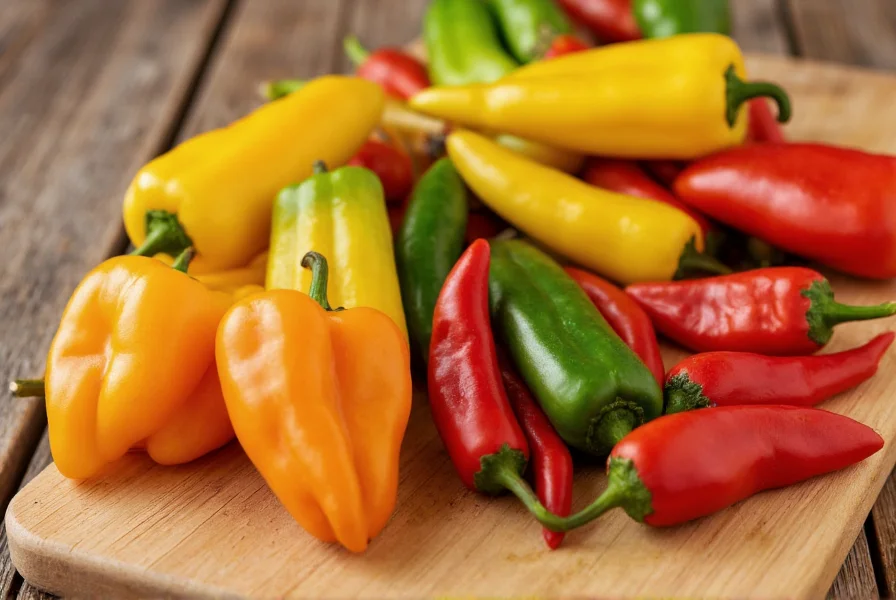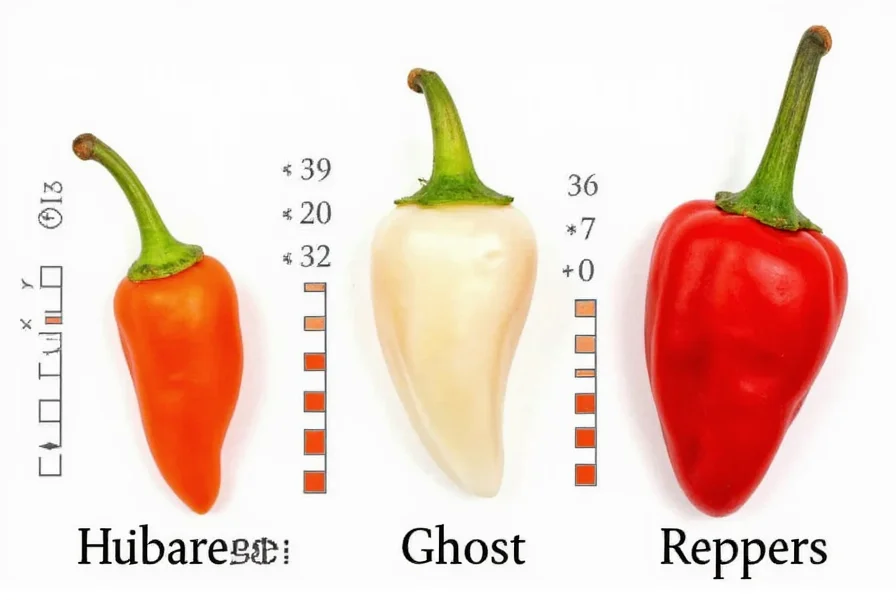The definitive types of chili peppers chart organizes over 30 common varieties by Scoville heat units (SHU), ranging from the mild 100-500 SHU bell pepper to the blistering 1,641,000+ SHU Carolina Reaper. This comprehensive reference includes visual descriptions, flavor profiles, and culinary applications for each pepper, helping cooks select the perfect spice level for any recipe.
Understanding chili pepper varieties is essential for both novice cooks and experienced chefs. With hundreds of cultivars worldwide, selecting the right pepper can transform a dish from bland to brilliant. This guide provides a scientifically accurate reference chart that categorizes peppers by heat level, appearance, and culinary application—saving you from unexpected spice disasters while expanding your flavor possibilities.
Decoding the Scoville Scale: Measuring Pepper Heat
The Scoville scale, developed by pharmacist Wilbur Scoville in 1912, measures capsaicin concentration—the compound responsible for chili heat. Originally determined through human taste testing, modern laboratories now use high-performance liquid chromatography for precise measurements. Understanding this scale is crucial when consulting any types of chili peppers chart, as heat levels can vary significantly based on growing conditions, with some peppers showing 50% variation in Scoville units.
Peppers are generally categorized into five heat levels:
- Mild (0-1,000 SHU): Bell peppers, pimientos
- Medium-Mild (1,000-15,000 SHU): Jalapeños, Anaheim
- Medium-Hot (15,000-100,000 SHU): Serranos, Tabasco
- Hot (100,000-350,000 SHU): Habaneros, Thai chilis
- Extreme (350,000+ SHU): Ghost peppers, Carolina Reapers
| Pepper Name | Scoville Range (SHU) | Appearance | Flavor Profile | Common Uses | Substitutes |
|---|---|---|---|---|---|
| Bell Pepper | 0 | Green, red, yellow, or orange; blocky shape | Sweet, vegetal | Stuffed peppers, salads, stir-fries | Pimientos |
| Poblano | 1,000-2,000 | Dark green, heart-shaped | Earthy, mild heat | Chiles Rellenos, mole sauce | Anaheim |
| Jalapeño | 2,500-8,000 | Green to red, 2-3 inches long | Grassy, bright heat | Salsas, guacamole, pickled | Serrano (use less) |
| Serrano | 10,000-23,000 | Green to red, slender 1-4 inches | Sharp, clean heat | Pico de gallo, hot sauces | Jalapeño (use more) |
| Habanero | 100,000-350,000 | Orange, red, or yellow; lantern-shaped | Fruity, floral, intense heat | Caribbean sauces, hot sauces | Scotch bonnet |
| Ghost Pepper (Bhut Jolokia) | 855,000-1,041,427 | Red or orange, wrinkled | Smoky, sweet, then intense burn | Extreme hot sauces, challenges | Trinidad Moruga Scorpion |
| Carolina Reaper | 1,400,000-2,200,000 | Bumpy red, small tail | Fruity start, delayed nuclear burn | World record hot sauces | None (use extreme caution) |
Mild Chili Peppers (0-15,000 SHU)
These approachable peppers provide flavor without overwhelming heat, making them ideal for everyday cooking. The poblano, when dried, becomes the ancho pepper—a cornerstone of Mexican mole sauces. The Anaheim pepper, often mislabeled as "New Mexico" in grocery stores, offers a gentle heat perfect for roasting and stuffing. When building your types of chili peppers reference chart, note that jalapeños can vary dramatically in heat; look for striations (white lines) as indicators of higher capsaicin content.

Medium-Hot Varieties (15,000-100,000 SHU)
The serrano pepper, commonly used in Mexican cuisine, delivers a cleaner, brighter heat than jalapeños with thinner walls that make them ideal for fresh salsas. The cayenne pepper, typically encountered dried and powdered, ranges from 30,000-50,000 SHU in fresh form. When consulting comprehensive types of chili peppers charts, you'll notice the Tabasco pepper (15,000-30,000 SHU) serves as the exclusive ingredient in the famous hot sauce, offering a distinctive vinegar-like tang when matured.
Hot and Extreme Heat Peppers (100,000+ SHU)
Habaneros and Scotch bonnets share similar heat profiles but differ regionally—Scotch bonnets dominate Caribbean cuisine with slightly sweeter notes. The ghost pepper (Bhut Jolokia) gained fame as the world's hottest until surpassed by newer cultivars. Notably, the Carolina Reaper holds the Guinness World Record, with some specimens testing over 2 million SHU. When working with these extreme peppers, always wear gloves and avoid touching your face—capsaicin oil can cause severe irritation even in minute quantities.

Practical Applications for Your Kitchen
Understanding pepper substitutions prevents recipe disasters. When a recipe calls for serranos but you only have jalapeños, use double the amount for equivalent heat. For habanero substitutions, the slightly milder Scotch bonnet works well in Caribbean dishes, while the fruity Aji Charapita (50,000-100,000 SHU) offers a gourmet alternative. Remember that heat concentrates in the pepper's placenta (the white ribs)—removing these reduces spiciness significantly without sacrificing flavor.
Proper storage extends pepper freshness: refrigerate unwashed peppers in the crisper drawer for 1-3 weeks, or freeze whole peppers for up to 6 months. For long-term preservation, dry peppers by threading them on string in a warm, dark place until brittle, then store in airtight containers.
Regional Variations and Naming Confusions
Pepper nomenclature varies globally, causing confusion in types of chili peppers charts. What Americans call "bell peppers" are "capsicums" in Australia. The "Thai chili" label often refers to multiple small hot varieties (50,000-100,000 SHU), not a single cultivar. In Mexico, "chile de árbol" (15,000-30,000 SHU) is frequently mistaken for the milder guajillo, though they differ significantly in heat and flavor profile. Always verify both common and botanical names when sourcing specialty peppers.
Frequently Asked Questions
Which pepper is hotter: habanero or jalapeño?
Habaneros (100,000-350,000 SHU) are significantly hotter than jalapeños (2,500-8,000 SHU)—up to 40 times hotter. One habanero can equal 20-40 jalapeños in heat intensity, though flavor profiles differ substantially with habaneros offering distinctive fruity notes.
How can I reduce the heat of a dish that's too spicy?
Add dairy products like yogurt or sour cream, which contain casein that breaks down capsaicin. Acidic ingredients like lime juice or vinegar can also help balance heat. For long-cooked dishes, adding more non-spicy ingredients dilutes the capsaicin concentration. Never use water—it spreads the oil rather than neutralizing it.
What's the difference between red and green jalapeños?
Green jalapeños are unripe versions of the same pepper that turns red when fully mature. Red jalapeños are slightly sweeter with more developed flavor, while green offer brighter, grassier notes. Heat levels are comparable, though some cultivars may vary slightly as they ripen.
Can I substitute cayenne pepper for fresh chili peppers?
Yes, but with caution. 1/8 teaspoon of cayenne powder equals approximately one medium jalapeño. Cayenne provides consistent heat without fresh pepper's moisture content, making it ideal for dry rubs and baked goods. For fresh pepper applications like salsas, consider using paprika for milder dishes or a combination of paprika and cayenne for controlled heat.










 浙公网安备
33010002000092号
浙公网安备
33010002000092号 浙B2-20120091-4
浙B2-20120091-4